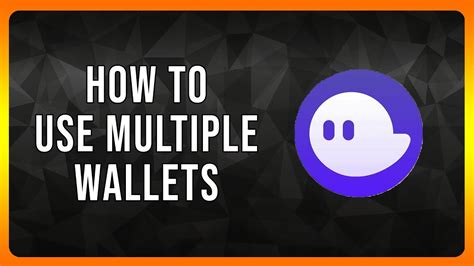Ethereum: Effective treatment of several wallets with a multi-clientian architecture
If you design a decentralized application or a blockchain-based project, it is of crucial importance to manage multiple items in the same system. An approach to solving the problem is the use of a multi-stage architecture, in which each wallet acts as a separate process for the Bitcoinclient. In this article, we examine the advantages and challenges when implementing such an architecture and discussing how they can be set up.
Advantages
The introduction of the multi-stage architecture of Ethereum-based articles offers many advantages:
- improved security *: Each wallet in its own process reduces the target area and minimizes the risk of simultaneous compromises or data violations.
- Simplified management : For several customers, it becomes easier to manage performance, transactions and balance of each wallet for separate processes.
- Better scalability : Multi-client architecture can promote the load distribution and improve the overall reactivity of the system, which makes the Ethereum-based application more scalable.
- Increased user experience

: Users will evaluate the increased separation of concerns between envelopes and reduce frustration due to accompanying collisions or errors.
Challenges
Although the implementation of the multi -stage architecture is useful, challenges must be taken into account:
- Use of resources : Each wallet requires a separate process with which system sources (CPU, memory and bandwidth) can be consumed if they are not treated properly.
- Via the API service : Due to the need for secure communication protocols, the management of several customers via an API service introduces additional complexity, delay and potential security risks.
- Debeting and troubleshooting : If several processes are carried out at the same time, debugging and troubleshooting each wallet can be a greater challenge.
Set multi -stage architecture
To implement several customer architectures, follow these steps on Ethereum-based token pockets:
- Select the implementation of a suitable wallet : Select the implementation of a wallet that supports the functions of several customers such as the "ETHWALLET" directory or the "Web3.js" API.
- Create a separate process for each wallet : Make separate processes for each wallet of a secure system (e.g. the Bitcoin client). This ensures that each wallet is separated and protected against potential safety threats.
- ** Use the API service to manage to manage to manage relationships to use a relaxing API or a news setting system such as RabbitmQ.
- Attention and optimization of the process performance : Monitor the performance of each wallet regularly, including CPU, memory and bandwidth. It optimizes the processes as required to ensure optimal use of the resources.
Example use the case
Suppose you have developed an Ethereum-based application with several items on a manufactured system. He decided to implement the "Ethwallet" directory for all customers with which users can manage their wallets via a single API service. Here is an example of high levels of how this architecture is executed:
` JavaScript
Const ethwallet = requires (‘ethwallet’);
// Create an API service to manage your wallet compounds
Const apiservice = New Ethereumapiservice ();
// Determine the API endpoint for the management of wallpaper relationships
app.post (‘/wallet’, (req, res) => {{{{
Const Wallets = Req.Body;
// processing of each wallet with separate processes with separate processes
Processwallets (wallets);
});
// Function for managing several wallets in a single process
Functional procedure wallets (items) {
Arright pockets.